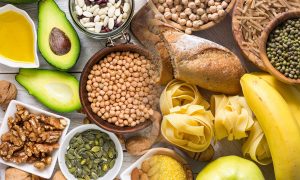Best Macro Ratio For Gaining Muscle, And Why

|
|
When it comes to health and fitness, people tend to think that losing fat is the toughest process you can put your body through, when in reality, many experts agree that building muscle is considered even tougher and far more strenuous on your body, both physically, and mentally. Of course burning fat is tough, it’s just a case of building muscle being even tougher. When you consider your ideal physique however, many people would agree that, in a perfect world, they would burn fat, and build muscle simultaneously, and that is where things get ridiculously tough. If you’re looking to make 2016 the year that you finally pull your finger out, and really begin making some decent gains and improvements to your physique, you are going to have to be willing to put in a great deal of hard work, dedication, and sacrifice, to get you to where you need to be. If you also happen to think that it is just a case of hitting the gym several times a week, and drinking the odd protein shake now and then, well, you are in for a very rude awakening indeed, as in actual fact, training in the gym is the easy part, the hard part is knowing what to do and eat in the kitchen. When it comes to building muscle, there’s a popular saying, that goes ‘muscle isn’t built in the gym, it is built in the kitchen’. Dialling in your diet and getting that in check, is notoriously difficult, yet if you take the time to track and calculate your macros, you stand a much better chance of actually being able to make some decent gains. Here we’ll be taking a look at the best macro ratio for gaining muscle, and exactly why that is.
First off, what are macros

Ok, the seasoned experts out there that are reading this, will already be well aware of what macros are, but for the rest of you, things may not be quite as black and white. Put simply, Macros, or macronutrients, are basically referring to the calories provided to your body in the form of: Protein, fats, and carbohydrates. Macronutrients are the key to health and fitness success, IF, you can dial them in and work out the perfect ratio depending on your goals and targets. Basically, think of macros as molecules used by the body in order to generate energy for itself. Macros are measured in grams, are found in all forms of food and drink, and, if you know what you’re doing, can really help you to reach your ideal goal physique or fitness objectives. Put simply, macros are the amounts of calories found in fat, protein, and carbohydrates. As muscle growth is your goal in this instance, there are a few things you will need to consider before you take the time to sit down and work out the optimal macro ratio split. To begin with, you will need to treat this process methodically, so there is no guessing or estimating, you will need to weigh, chop, add, or remove foods and ingredients until you have the perfect split. With that being said, here’s a look at how to calculate and work out your macro ratios for building muscle.
Begin by setting your protein intakes
Protein is absolutely vital for building muscle, as it plays a key role in protein synthesis, in the growth and repair of lean muscle tissue, as well as in cellular health and functioning as well. Not only can protein help you to build muscle, it can also rev up your metabolism and help you to burn away stubborn body fat. If you aren’t consuming enough protein, not only will your muscles not recover after working out, your body in general will not function correctly, as it is basically made up of billions of cells, which depend, in part, on proteins and the amino acids that they contain. However, if you consume too much protein, you will struggle to be able to consume enough healthy fats and carbohydrates, which also must be incorporated into your diet and nutritional regime. Experts agree that individuals who lift weights regularly, should be aiming for considerably more protein than the average person, with numbers being anything from 50% more, all the way through to 250% more. In order to see optimal results, you should be consuming between 1 and 2 grams of protein per pound of bodyweight, with many people aiming to go right down the middle and sticking with 1.5 grams per pound of weight. Only get your protein from fresh and healthy foods and supplements, so avoid processed junk foods.
Next, set your fat intakes

Fat is not to be feared, fat is your friend, especially if you’re looking to bulk up leanly and trim down. This may sound odd to some people, as the thought of eating fat to lose fat may seem pretty bizarre, but trust us, there is heaps upon heaps of research and evidence that proves that fat is vital for the human body. Fat helps to provide energy, fat helps to stabilize and regulate our hormones, including HGH and testosterone, and fat also helps to keep us feeling satisfied and full. People who follow low fat diets often have low testosterone and energy levels, both of which are the exact opposites of what you should want if you’re trying to bulk up. Now, before you jump for joy and begin reaching for the pizza, just remember that healthy fats are far, far better for our bodies, and make us look and feel much healthier. Healthy fats such as monounsaturated fats, and polyunsaturated fats, are typically found in foods such as: oily fish, nuts, seeds, nut butters, whole eggs, avocados, and healthy oils. Most people aim for 20 – 40% of fat from calories, but don’t worry, we’ll break things down a little simpler before we wrap things up.
Finally, set your carbohydrate intakes
Last but not least, we’ll finish things off by taking a look at your carbohydrate intakes. Carbohydrates are also essential for the body, so unless you plan on following a specialist diet such as Keto, you are going to want to include plenty of carbs on a daily basis. Many experts agree that, ideally, you should consume around 1.5 – 3 grams of carbohydrates, for every pound that you weigh. As far as carbohydrates go, most of your carbs will need to come from low GI sources of complex carbohydrates, as these provide slow and steady releases of energy and nutrients, without causing imbalances in hormone levels, especially insulin. There is one exception to this rule however, which is immediately after you workout, as this is where you will need a simple carb source rich in sugar, as that will lead to a spike in insulin levels, which then shuttles nutrients into your muscles, which will now be like sponges due to their depleted glycogen levels following your workout. For the rest of the time however, complex carbs are your friend.
So, what is the best macro ratio for building muscle?

Although it would be great if we could tell you that, you need X amount of protein, X amounts of fat, and X amounts of carbs to be able to build muscle, in reality, it all depends on the size of the individual, their goals and diet preferences, their sensitivity to certain macros, and their activity levels. For example, if an individual is sensitive to carbs, their carb intakes may want to be on the lower end of the spectrum. To help make things a little clearer however, here’s a typical look at the kind of macro ratio split that most people trying to build muscle tend to follow:
Protein: 35%
Carbohydrates: 45%
Fats: 20%
Alternatively, another popular split would look like:
Protein: 30%
Carbohydrates: 40%
Fats: 30%
Tips for calculating your macros
So, before we wrap things up, as we know that calculating and counting macros can be pretty tricky and confusing in the early stages, here’s a look at a few handy tips to help you along:
Weigh your foods – Before you go any further, the first thing you will need to do if you’re serious about calculating and counting your macros, is to invest in a decent set of weighing scales so that you can weigh your food. That way, you aren’t leaving anything to chance, as you will then know exactly which foods contain what, in terms of your macros.
Be patient – Counting and calculating macros is an art, and it won’t come to you overnight. Take your time, be patient, practice before you get serious with your diet, and don’t get frustrated if you mess up.
Learn as you go – Finally, the last thing you can do to really help you out, is to basically learn as you go. Read articles and forums, ask experts for help, and try to pick things up as you go. To begin with, you will need to weigh everything, but a few months down the line, you will know exactly what you need, just by look and feel alone.














